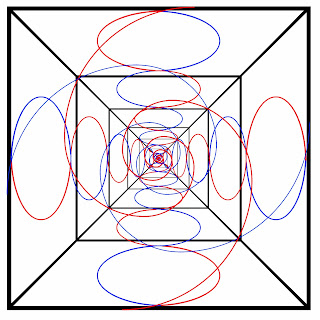The trick is to get 3 torus into a single sphere shape. There should be no ultimate reliance on the single torus model to create a 4 dimensional Euclidean Space topology. Poincare Conjecture and its solution to closed 3-sphere manifold issues show the 3 torus model to be much more accurate than a mere single torus model.
Is it because the form gets too complex with 6 vortexes having to reconcile spin states and coherence that sacred geometry/torus proponents such as Nassim Haramein and Marko Rodin refuse to take into consideration in accordance to multi-dimensional mass, charge and electric fields formed from the primordial aether?
| Stereographic projection of the hypersphere's parallels (red), meridians (blue) and hypermeridians (green). Because this projection is conformal, the curves intersect each other orthogonally (in the yellow points) as in 4D. All curves are circles: the curves that intersect <0,0,0,1> have infinite radius (= straight line). |
I admit, it is a tough problem and daunting to wrap the mind around,
much less dissect. Think of a sphere with 3 inward rotating vortexes and 3 outward rotating vortexes, and a single convergence area. The
entire construct must be both repulsing and attracting at the same time,
even down into the fractal states, past the quantum critical state and
through the post-chaos of quantum potential of Werner Heisenberg's Uncertainty Principle.
 |
| For compact 2-dimensional surfaces without boundary, if every loop can be continuously tightened to a point, then the surface is topologically homeomorphic to a 2-sphere (usually just called a sphere). The Poincaré conjecture asserts that the same is true for 3-dimensional spaces. |
- Chad Adams


.jpg)
.jpg)





No comments:
Post a Comment